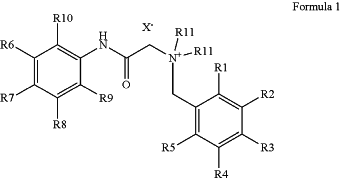| CPC C07C 237/04 (2013.01) [A61K 47/186 (2013.01); A61K 47/54 (2017.08); A61K 47/65 (2017.08); C07C 231/12 (2013.01); C07C 233/07 (2013.01); C07C 269/04 (2013.01)] | 3 Claims |
|
1. A compound of general formula 1
 wherein:
(i) X− represents halogenide, sulphate, benzoate, acetate, trifluoroacetate, hydroxide, saccharinate, or capsaicinate,
(ii) R1-R10 independently represent:
(a) hydrogen,
(b) halogen,
(c) C1-C5 alkyl,
(d) C1-C4 alkoxy,
(e) C1-C20 alkoxycarbonyl
(f) —NH—P or —O—P, wherein P is a hydrogen
or a residue consisting of 1-30 amino acids selected from the group consisting of D-amino acids, L-amino acids and unnatural amino acids, wherein said amino acids are optionally modified for coupling,
(g) —(Y)n—COOM with M=Na, K, or [N(R12)4]+, or
(h) —(Y)n—C(O)NR14R15, further wherein Y represents an organic residue selected from the group consisting of: —CH2, —CH(CH3)—, —CH2—CH2—, —(CH2)3—, —CH═CH—, —C≡C—, —O—CH2—CH2—, —O—CH2—CH2—O—CH2—CH2—, and —NH—CH2—CH2— and n=0 or 1,
(iii) R14 and R15 represent hydrogen, a C1-C12 alkyl, or a residue consisting of 1-30 amino acids selected from the group consisting of D-amino acids, L-amino acids and unnatural amino acids, and
(iv) at least one of the residues R1-R10 is a (a) —(Y)n—COOM or (b) —(Y)n—C(O)NR14R15, wherein Y, M, R14, and R15 are as defined above, and
(v) R11 and R12 independently represent hydrogen or a C1-C10 alkyl residue.
|